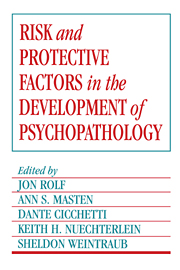Book contents
- Frontmatter
- Contents
- List of contributors
- Preface
- Part I Introduction: Historical and theoretical roots of developmental psychopathology
- Part II Contributions of the high-risk child paradigm: continuities and changes in adaptation during development
- Part III Competence under adversity: individual and family differences in resilience
- Part IV The challenge of adolescence for developmental psychopathology
- Part V Factors in the development of schizophrenia and other severe psychopathology in late adolescence and adulthood
- A closing note: Reflections on the future
- Author index
- Subject index
Preface
Published online by Cambridge University Press: 06 August 2010
- Frontmatter
- Contents
- List of contributors
- Preface
- Part I Introduction: Historical and theoretical roots of developmental psychopathology
- Part II Contributions of the high-risk child paradigm: continuities and changes in adaptation during development
- Part III Competence under adversity: individual and family differences in resilience
- Part IV The challenge of adolescence for developmental psychopathology
- Part V Factors in the development of schizophrenia and other severe psychopathology in late adolescence and adulthood
- A closing note: Reflections on the future
- Author index
- Subject index
Summary
This volume is a tribute to Norman Garmezy by students and colleagues he has influenced during four decades of research and teaching. Norm has been described as the Johnny Appleseed of American psychology, planting ideas around the world concerning risk, competence, and protective factors in the development of psychopathology. The fruits of his ideas and research are reflected in the diverse chapters of this volume, which span infancy to adult development.
Garmezy has had a profound influence on the direction of research in psychopathology, pioneering new areas of study throughout his career. One abiding interest has been understanding the roots of schizophrenia. Initially, he studied this serious disorder in adults (Garmezy, 1952a,b; Rodnick & Garmezy, 1957). The theme of competence, a hallmark of Norm's career, soon emerged as he and Elliott Rodnick studied the role of premorbid competence in schizophrenia (Garmezy, 1970a; Garmezy & Rodnick, 1959).
Norm's interest in the etiology of schizophrenia took a new turn in Minnesota as he, along with a cadre of students and other pioneering investigators, adopted the “risk” strategy for studying the development of schizophrenia (Garmezy, 1974a, 1976; Garmezy & Devine, 1984; Garmezy & Streitman, 1974). His influence in this area is evident in chapters in this volume written by students who trained with Norm during this period of focus, including Regina Driscoll, Keith H. Nuechterlein, Susan Phipps-Yonas, Jon Rolf, and Sheldon Weintraub, as well as chapters by colleagues in the risk consortium.
Once again the theme of competence quickly surfaced. Garmezy immediately recognized the significance of the large proportion of high-risk children who, often despite adverse rearing conditions, appeared to develop well.
- Type
- Chapter
- Information
- Risk and Protective Factors in the Development of Psychopathology , pp. xiii - xviPublisher: Cambridge University PressPrint publication year: 1990

